When did we last feature wood ducks? A couple of weeks ago? That’s enough of a gap.
Yesterday I looked out the office window and found a pair of the wood ducks (Aix sponsa) hanging out on the little log that serves as a turtle basking spot for the smaller species. They had a good view directly into my office window themselves, and so I shut off the lights therein to hopefully not disturb them, since this was the upper portion of the main pond, near the nesting box, where they don’t visit that often. So far, there’s been no further interest in the nest box, but this pair seems to be more mellow and hanging around a lot while all of the others only visit twice a day during their own specified feeding times.
Only a minute or three later, I noticed that the male had switched ends of the log while the female snoozed, and realized that he’d probably shifted to make way for a turtle, so I had to try for the shot.
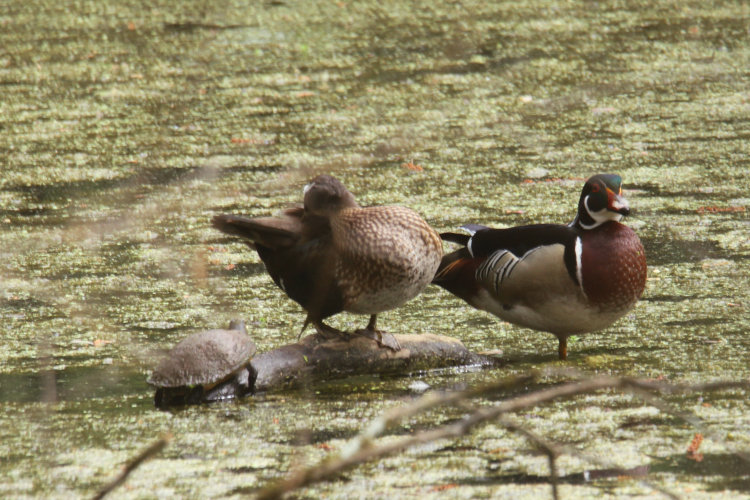
The way the place is laid out, my office door leads out back from slightly below grade, so I have a few steps up to ground level, and this stairwell is shielded by latticework. I’ve tried before and the ducks easily notice me moving behind the lattice before I can shift the long lens around the end, so this time I got just clear enough to shoot through the lattice openings. This is far from ideal, since the openings are smaller than the front element of the lens; what happens is, a certain percentage of the light coming in is the white latticework itself, well out of focus but still contributing its pale coloration to the frame, reducing contrast and washing it out a bit. I’m considering how to change this so I can get clear shots from my door, but this is what we have for now.
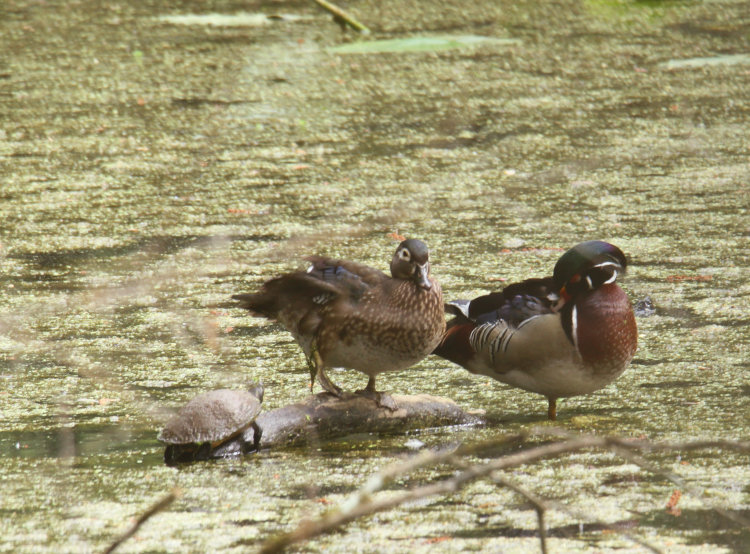
I got a couple of frames as they preened, then stopped taking any further chances of them noticing me, but at least these two seem much better about human presence than the rest: even when they notice us outside, often all they’ll do is scoot over a bit to be obscured by branches or trunks, rather than fleeing with alarm calls as most of the others do. They’re nowhere near coming up for food when we appear like the geese and mallards will, but at least they stick around.
A little after this, as The Girlfriend and I watched from an upstairs window with binoculars, the female found something disagreeable with the turtle, leaning down and shoving it back into the water. Would have made a cute video clip, had I been ready.
That evening, I went out exploring by headlamp, mostly in search of snakes but also to see if the beaver(s) might make an appearance. Now, the property layout is, all of the east side is ponds, with a narrow spit of land that separates them from the nearly-still creek that forms the property boundary. Most of the beaver activity is on this creek, though there’s evidence that they come into the ponds on occasion, just not too often. The foliage, primarily bamboo, is quite dense on this spit of land along the creek and there are just a couple of places where clear views of the water can be had, which are the only places I’ll be able to see any beavers in the water. Last night I heard a splash, but not quite the sound of a beaver tail, then a flutter that told me that some waterfowl had launched itself from the water and landed again some ways downstream. I did eventually see the reflections of a beaver’s eye in the headlamp, out in the creek, but it quickly moved further off and was obscured by branches before I could begin to focus (using my trusty Beav Team Six rig.) I stood and waited, and realized I was hearing some soft peeping from right on the other side of the creek. I peered around, watching carefully, and eventually determined that a male wood duck was hanging around immediately opposite me.
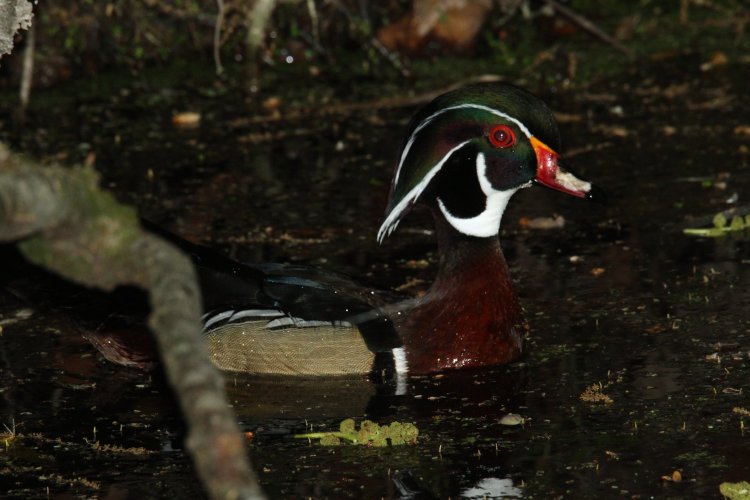
This was the closest I’ve ever been to one, and I credit it to the bright headlamp and rig focusing light that was preventing the duck from seeing me clearly – this is full-frame at 600mm, by they way, while the duck was perhaps seven or eight meters off. The light is provided by a Vivitar 285 HV, the most powerful strobe I own. Mr Bugg would have been delighted to see me chimping, but it was the quickest way to calculate the proper exposures. Meanwhile, the male wood duck seemed disinclined to vacate the area and continued its calling; I surmised this was to attract the female that had left, so they could stay together, but that’s only a guess.
I worked further on to not disturb him, still looking for other subjects, still hearing beaver activity but not seeing it. On my way back, I returned to the same spot and had a seat to just try and wait one out. I’d looked around quite carefully and had seen nothing as I settled in.
After a few minutes, there was a splash nearby, and as I homed in on it, expecting to see the ripples of a beaver, I found the male wood duck again, who had not been visible there only moments before.
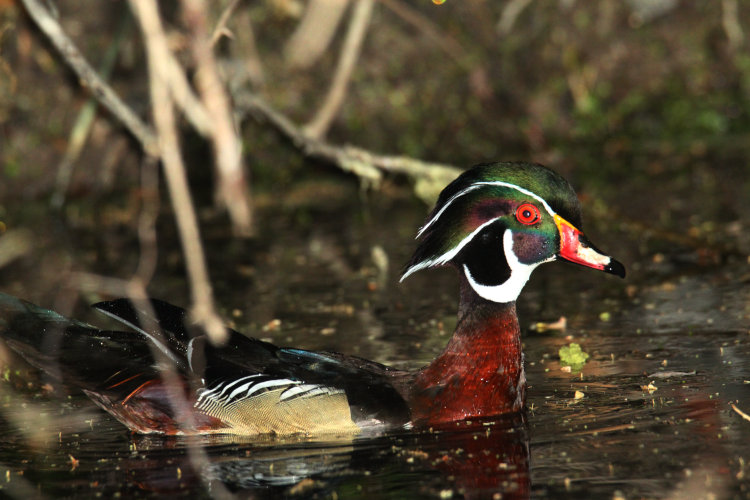
Now, I don’t know how good the night vision of a wood duck is. For most birds, it falls somewhere between terrible and nonexistent, and they take pains to have safe perches before full darkness descends. The exceptions that I know of are the owls of course, as well as nightjars and great blue herons, which seem to have no trouble flying at night. Wood ducks? I have no idea, but this one was not only hanging around the area, it might have purposefully landed right near me. And again, it was swimming back and forth, not ostentatiously, but still peeping very softly. It also gave me a brief flapping display, which I was barely fast enough to capture.
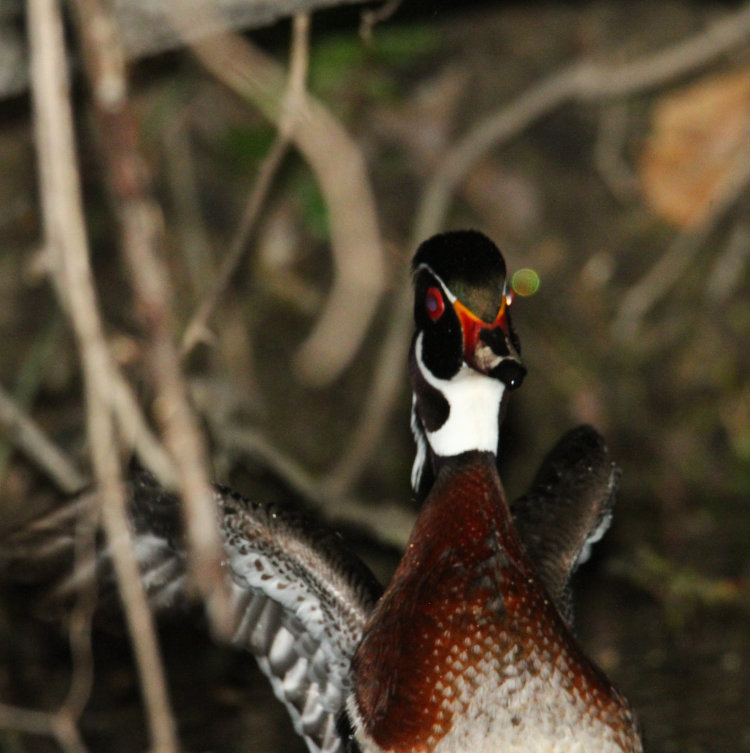
I have a sneaking suspicion that there’s a nest nearby, perhaps in one of the trees I was sitting under, and the male was keeping an eye on things, if not actively trying to draw me away. I knew, should the nest exist, I had little chance of spotting it by the headlamp, so I elected to return in daylight to test this theory, because that’s exactly the kind of thing that I want to monitor, if I can find a way to do so without disturbing them – a tall order, that, especially since I’ve found no way to get to the other side of the creek where I could be farther off and less threatening; with luck, should the nest exist, it will be on the far side and I can try to find a safe observation spot on our own property.
By the way, I cannot stress enough how useful a good headlamp is. I’ve had this one for years, having replaced the elastic bands twice and the rechargeable batteries at least that many times, and it’s seen heavy use in not just photography, but household tasks like entering the crawlspace or working in tight quarters where light doesn’t penetrate, and even working on cars at night on the side of the road. It has multiple lighting modes and the batteries last for hours of constant use, which is damn good because I wouldn’t be able to do excursions of this nature without it. I highly recommend that everyone have one.
I close with one little detail that I discovered while reviewing the photos last night, seen here close up:
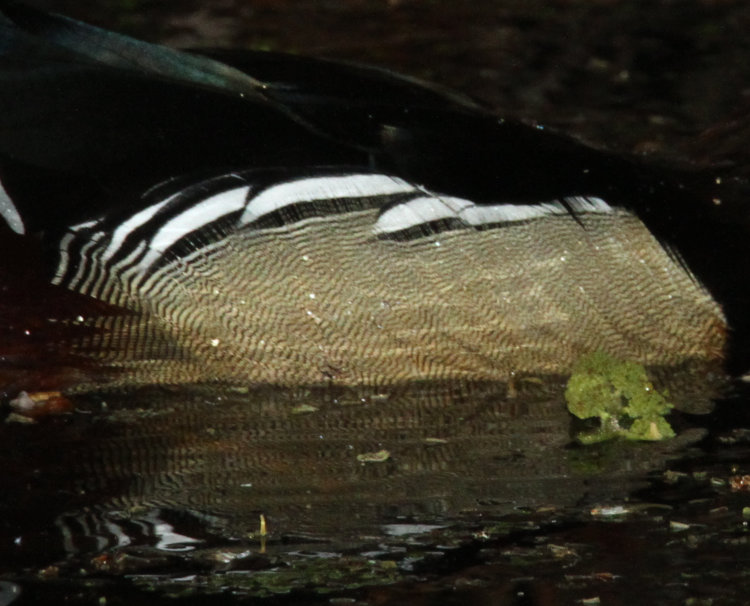
Every photo I have seemed to show that the sides of the males were simply tan, but now I see that they’re actually stippled very finely, making me feel bad because I don’t have that detail on my wood duck figure (I really am bothered by inaccuracies like that, even though only a small percentage of people would spot it themselves.) Now, do I have the patience and steady hands to correct this oversight? Yeah, not sure about that…




















































Hey chimpy go chimp
Man, took you long enough!